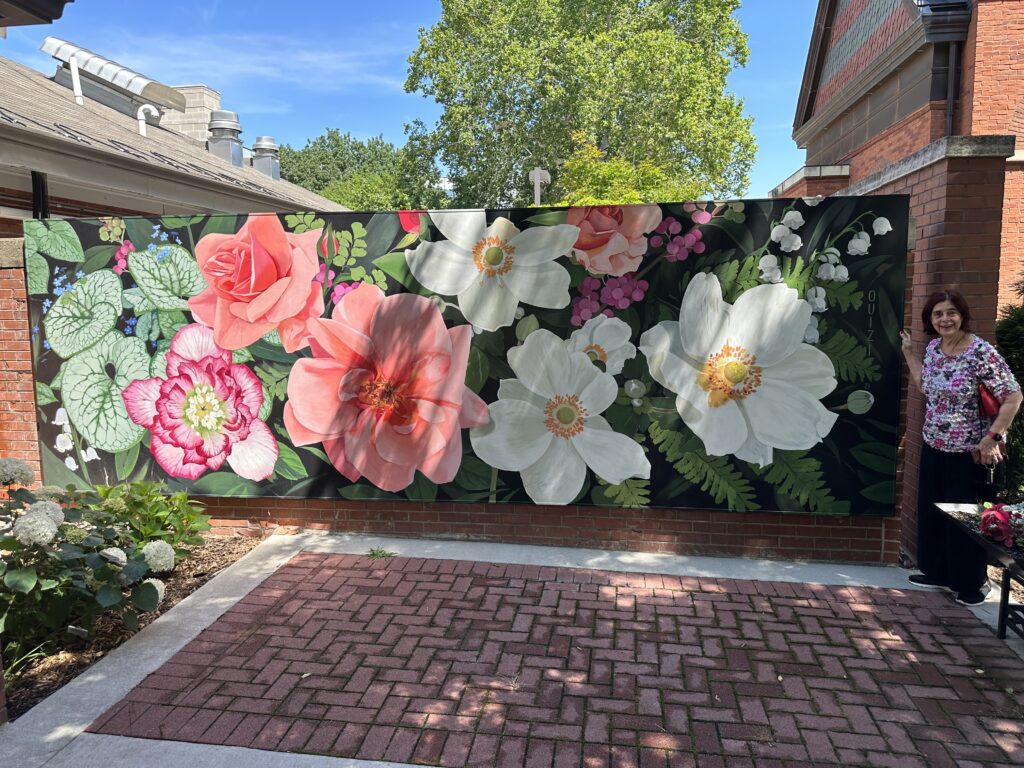
About the Art
Hidden Gems of the Sculpture Garden (Hidden Gems) was developed through conversations with horticulturalists, curators, and other artists in 2021. Louise “Ouizi” Jones thought of the mural during a campus tour in the spring, where she was moved by the rich landscaping of the Ada Hayden Herbarium and Reiman Gardens. Located in the Anderson Sculpture Garden outside of The Christian Petersen Art Museum, Jones modeled the colorful, yet delicate flowers and foliage after the ones planted in the area.
This educational and encyclopedic mural references real plants in the garden. Jones carefully chose each flower based on their color, meaning and shape. The peach-colored (Honeysweet) rose is named after Griffith J. Buck, a famed ISU professor of horticulture who bred these hardy roses while working at the university. Other flowers include: Brunerra (small blue pentamerous with white center); Japanese anemone (white with yellow center with 6-9 petals); Hellebore (purple flower with white and gold center pentamerous flower); Adiantum (“Maidenhair fern); Lily of the valley (small bell-shaped white flowers); and Beautyberry (groups of purple berries).
The flowers depicted in the mural bloom in different seasons. Hidden Gems allows you to experience them all year long.
About the Artist
Louise Jones (aka “Ouizi”) was born in 1988 and raised in Santa Monica, California. She is a Shanghainese-American. As a child, she would paint flowers with her mother, using watercolors. Jones is best known for her large-scale public floral mural installations. The murals often depict site-specific plants and animals, and the techniques she uses are uniquely informed by her background in drawing and printmaking. Her specialization in portraying botanical subjects in her art originates from her early interest in Georgia O’Keeffe. Jones currently lives and works in Detroit, has painted murals around the Chicago area, and continues to showcase her signature floral motif.
Example of Jones’ murals follow.
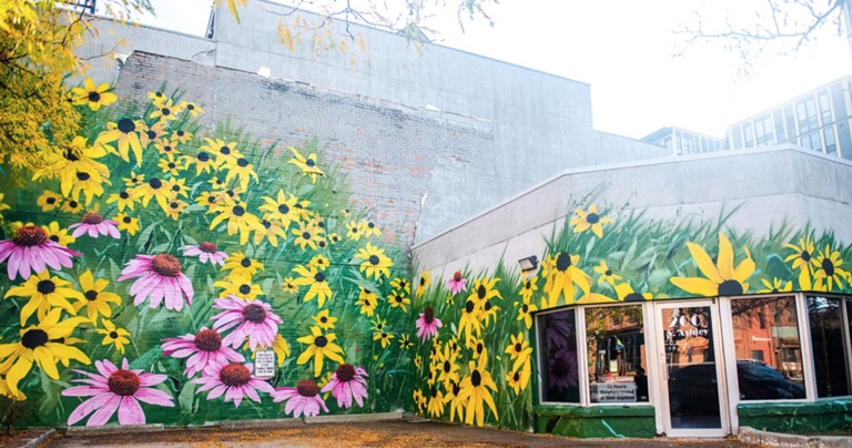
DRIFTS, Ann Arbor, Michigan
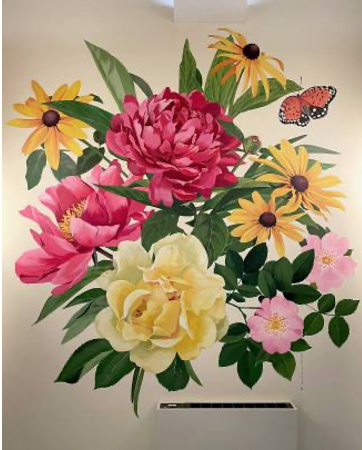
A Cultivated Beauty, 2021, Iowa State University, Morrill Hall, Ames, Iowa
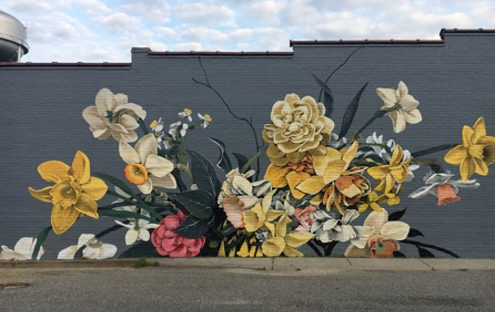
Gloucester, Virginia
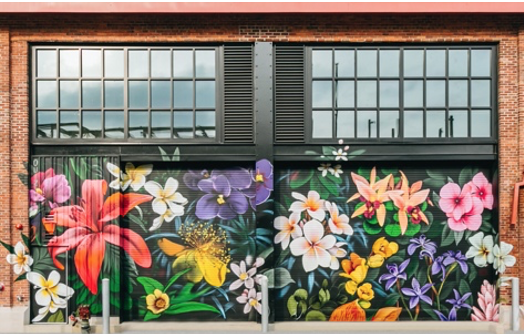
Watertown, Massachusetts
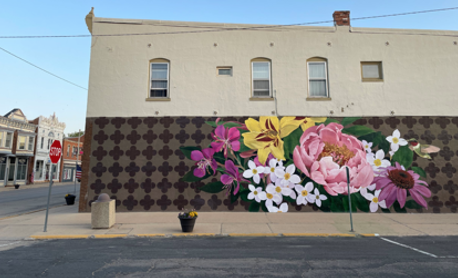
Stockton, Illinois
Relevant Terminology/History
Georgia O’Keeffe (1887-1986) was an American modernist painter and draftswoman. Called the “Mother of American modernism”, O’Keeffe gained international recognition for her meticulous paintings of natural forms, particularly flowers and desert-inspired landscapes, which were often drawn from and related to places and environments in which she lived.
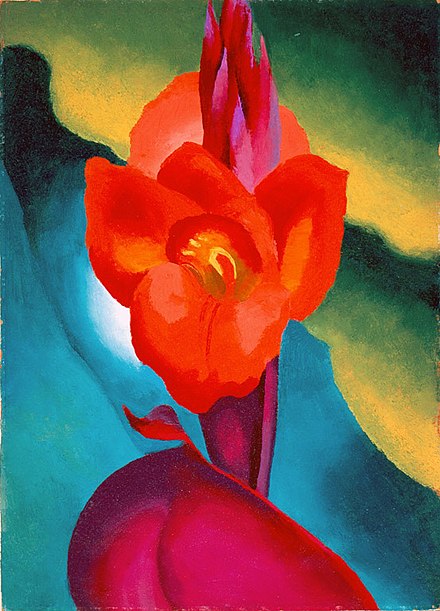
Red Canna, 1919, Georgia O’Keefe, High Museum of Art, Atlanta, Georgia

Sky Above Clouds IV, 1960, Georgia O’Keefe, Art Institute of Chicago, Chicago, Illinois
A gem is an object ofhigh quality or value. Like a treasure, a gem is prized, like a treasure, a gem is prized because of its beauty or worth.
A gemstone refers to any mineral that is highly prized for its beauty, durability, or rarity. Most gemstones begin as crystals of minerals (such as diamonds or sapphires), or as aggregates of crystals (such as malachite or jadeite). A limited number of non-crystalline materials of organic origin (such as pearl and amber) are also classified as gemstones and are usually referred to as organic gems. Gemstones are hard, but some soft minerals are used in jewelry because of their luster or other physical properties that have aesthetic value. Rarity and notoriety are other characteristics that lend value to gemstones.
Raw gemstones can be enhanced to create more elegant gemstones by altering their shape, usually by polishing and/or cutting into cabochon or faceted shapes.
Cabochon is a gemstone that has been shaped and polished rather than faceted.
Cutting Cabochon is the best way to display colors and other optical effects in opaque or translucent stones is to cut them en cabochon– with a rounded upper surface and a flat underside. Cabochons are cut and polished on abrasive wheels, The stone is first ground to its outline shape and then the top is ground and polished into a dome using progressively finer abrasions. Stones have been cut into cabochon shapes for jewelry or decorating exquisite objects for centuries.
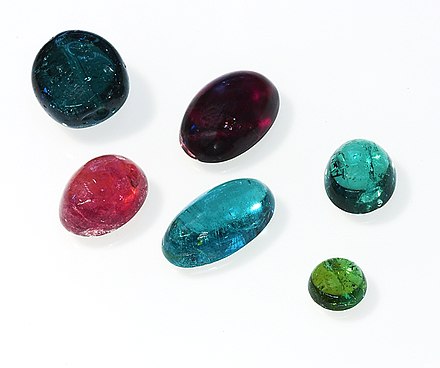
A collection of tourmaline cabochons, image courtesy of Wikipedia.
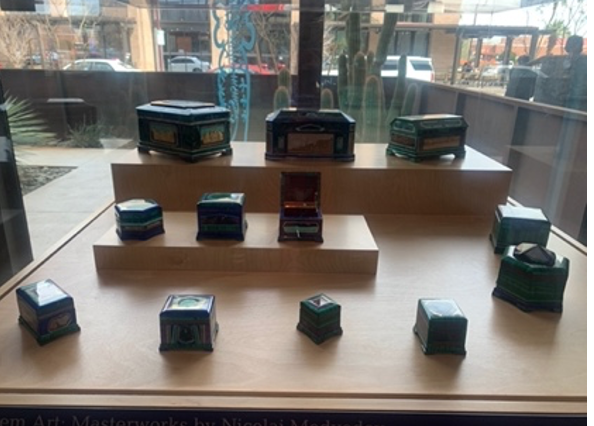
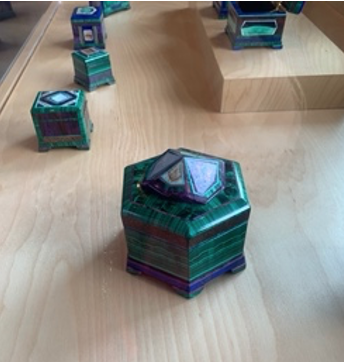
Boxes of cabochon cut gems by Nicolai Medvedev. The boxes are made from malachite-stalactite, turquoise, sugilite, opal, gold in quartz, lapis, and jasper. Images courtesy of Dr. Klemm on her trip to Arizona in June 2023.
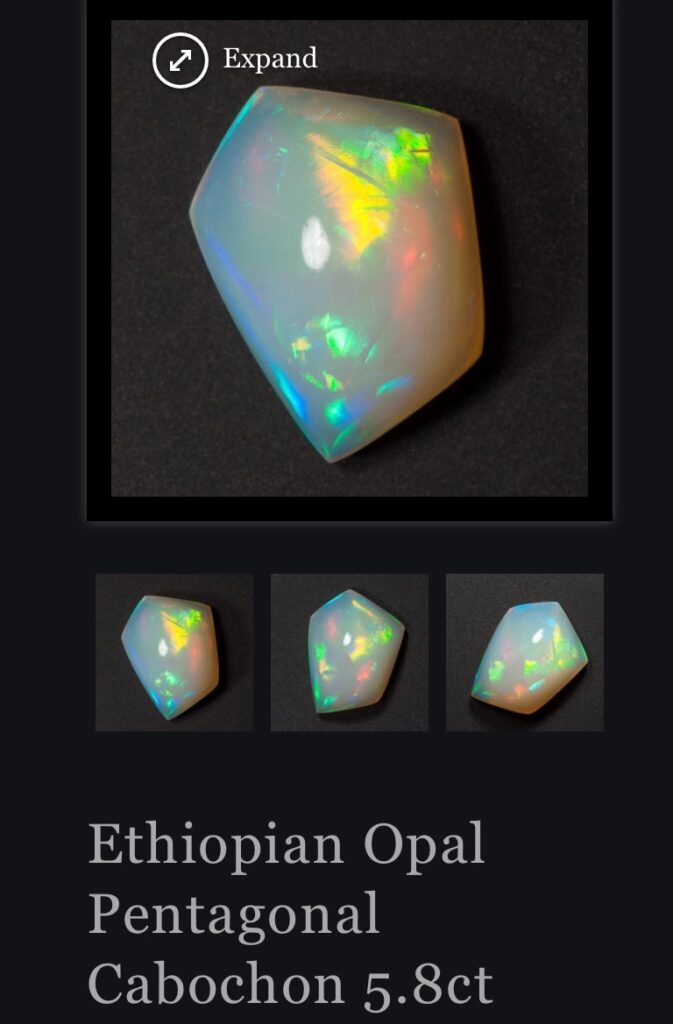
Image of an opal, which is translucent.

Image of black jade, which is opaque.
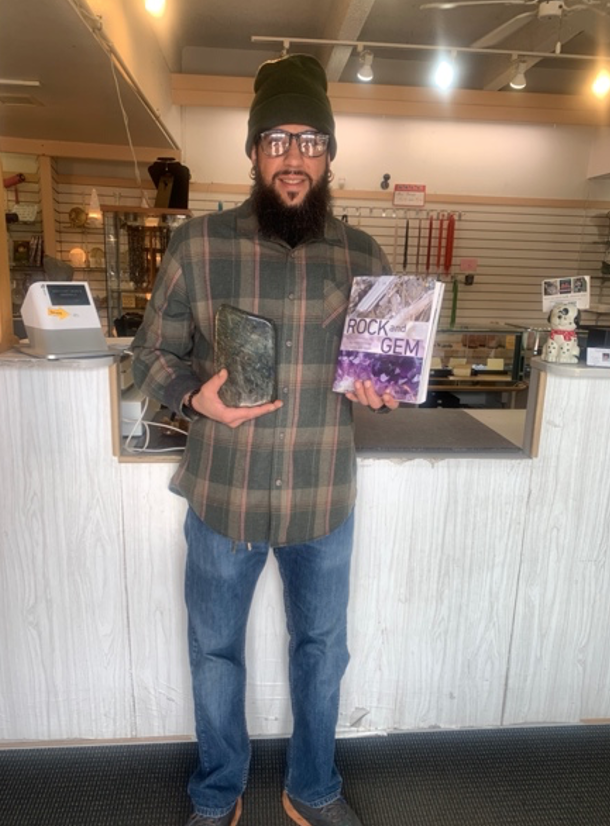
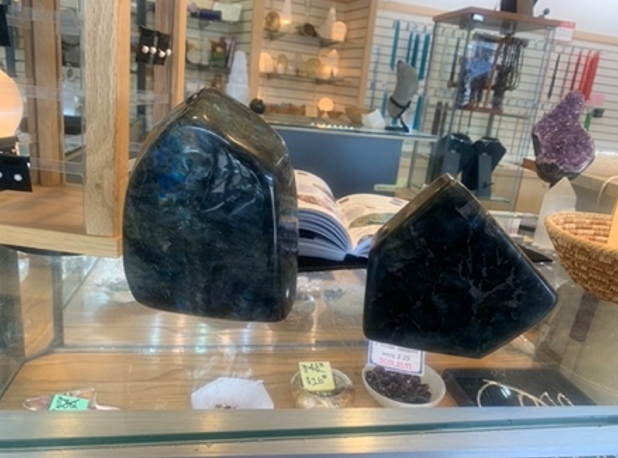
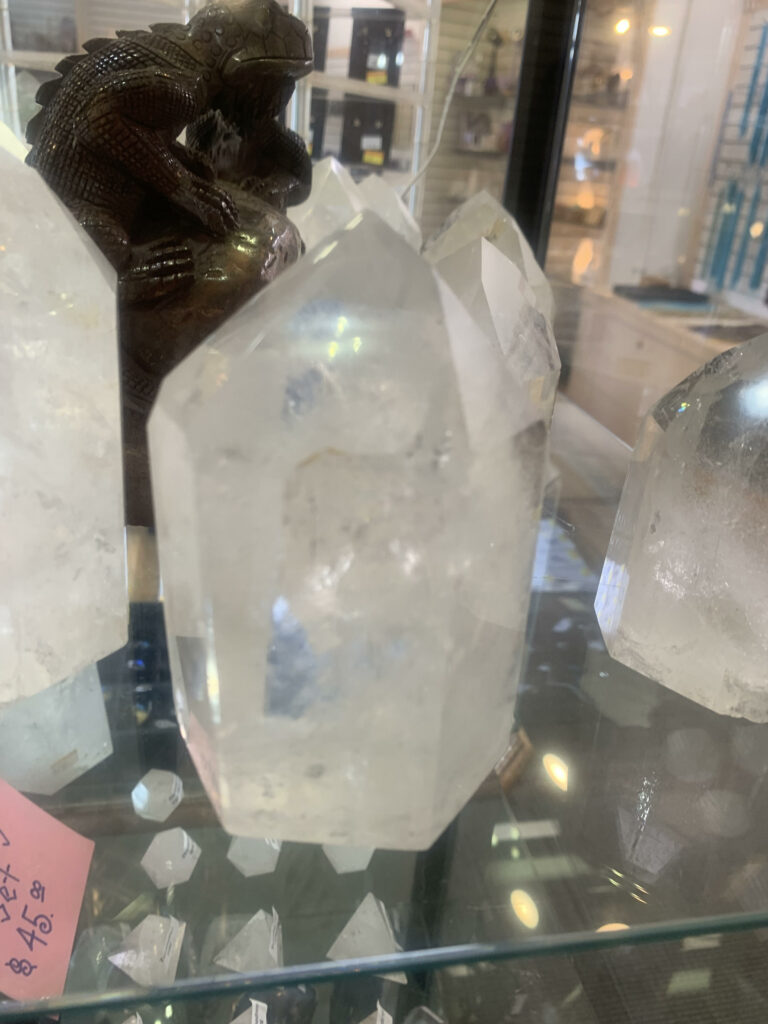
Retail Assistant Ram Ji at Discount Gems & Minerals in Sedona, Arizona, is holding a cabochon gemstone and a copy of the book Rock and Gem: The definitive guide to rocks, minerals, gems, and fossils by the Smithsonian Institute. All gemstones above are cabochon gemstones mostly of pentagonal shape. The dark colored ones are Labradorite from Madagascar. The crystals are Clear Quartz from Brazil .
Faceting is the best way to maximize the beauty of a transparent raw gemstone by cutting it into flat reflective faces called facets. The ideal product of facet cutting is a gemstone that displays a pleasing balance of internal reflections of light known as brilliance, strong and colorful dispersion (aka “fire”), and brightly colored flashes of reflected light known as scintillation. Typically transparent to translucent stones are faceted, although opaque materials may occasionally be faceted as the luster of the gem will produce appealing reflections.
Early faceting of transparent stones into beads, scarabs, amulet seals, and bowls began around the 1300s and faceting of diamonds began around the end of the 1700s by European cutters.
Different outline shapes lend themselves to different cuts. Square or rectangular shapes suit the step cut. Round or oval shapes suit the brilliant cuts. Mixed cuts can be used on both.
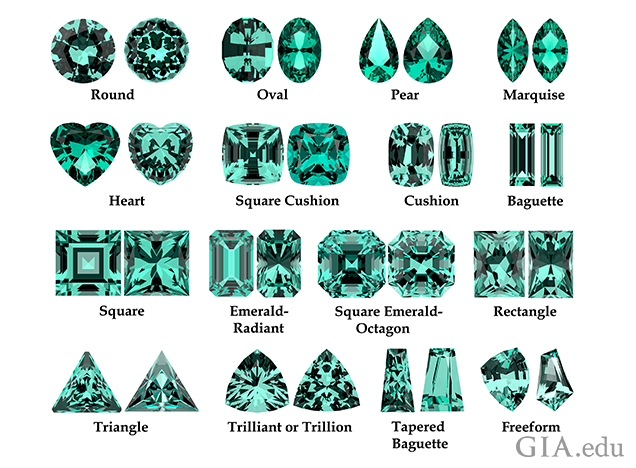
Image of faceted gemstones courtesy of Getty images.
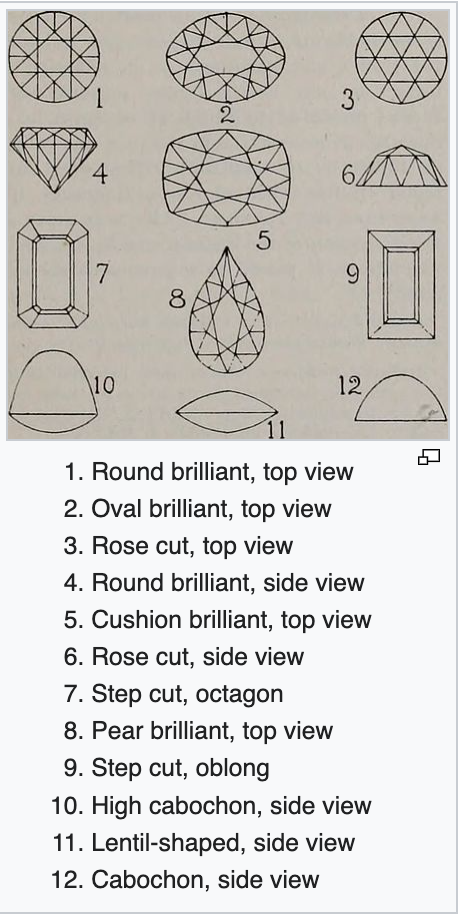
Image of rose and mogul cuts, courtesy of Wikipedia
Fun facts about sapphires, turquoise, and lapis lazuli:
The sapphire is a stone that is often enhanced into both cabochon and faceted gems.

Star Cabochon – When a sapphire stone that contains rutile needles oriented along the growth directions of the crystal is cut en cabochon, a star appears.

Brilliant – A brilliant cut is usually used for transparent sapphire to enhance its color.
Turquoise is an opaque, blue-to-green mineral that is a hydrous phosphate of copper and aluminum. It is rare and valuable in finer grades and has been prized as a gemstone for millennia due to its unique hue. The Southwest United States is a significant source of turquoise: Arizona; California; Colorado; New Mexico; and Nevada are especially rich.
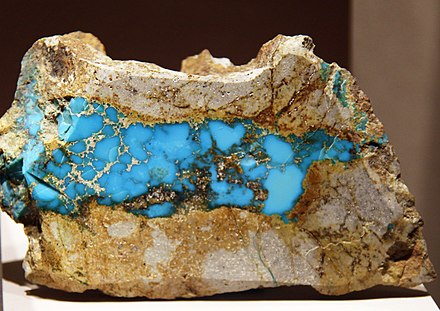
A fine turquoise specimen from Los Cerrillos, New Mexico, US, at the Smithsonian Museum. Cerrillos turquoise was widely used by Native Americans prior to the Spanish conquest, image courtesy of Wikipedia.
Lapis lazuli or lapis for short, is a deep-blue metamorphic rock used as a semi-precious stone that has been prized since antiquity for its intense color. In ancient Egypt, lapis lazuli was a favorite stone for amulets and ornaments such as scarabs. Prized for thousands of years, Lapis was a favored stone in ancient Egypt, where it was believed to lead the soul into immortality and open the heart to love. Cleopatra’s iconic blue eye shadow was originally dust of Lapis Lazuli stones. Lapis Lazuli is believed to restore calmness and improve mental clarity in the wearers.

Mask of Tutankhamun, gold, lapis, carnelian, obsidian, turquoise and glass paste, Egyptian Museum, Cairo, Egypt
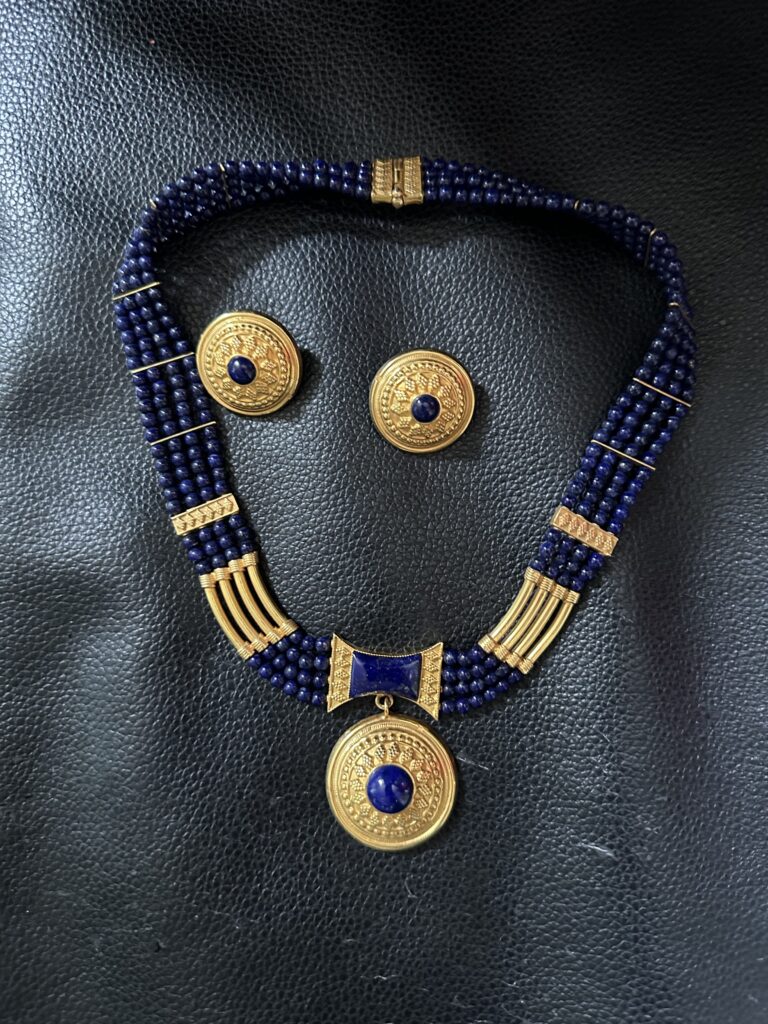
Necklace and earring of gold lapis lazuli balls. From the personal collection of Dr. Klemm, purchased in Luxor, Egypt, c. 1980.
Flora and fauna are all the plant life and animals present in a particular region or time.
Griffith J. Buck is an American professor and a horticulturist. He taught horticulture at Iowa State University, and he created over 80 named cultivars of the rose, all of which are capable of withstanding temperatures of -20 °F and need no pesticides or fungicides to thrive. The Honeysweet (see below) is one of the roses.
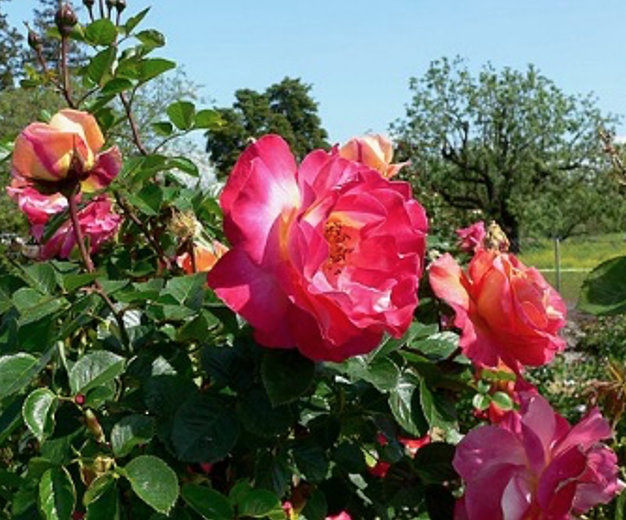
Honeysweet, 1984, Image courtesy of Wikipedia
Pentamerous flowers have multiples of 5 petals.
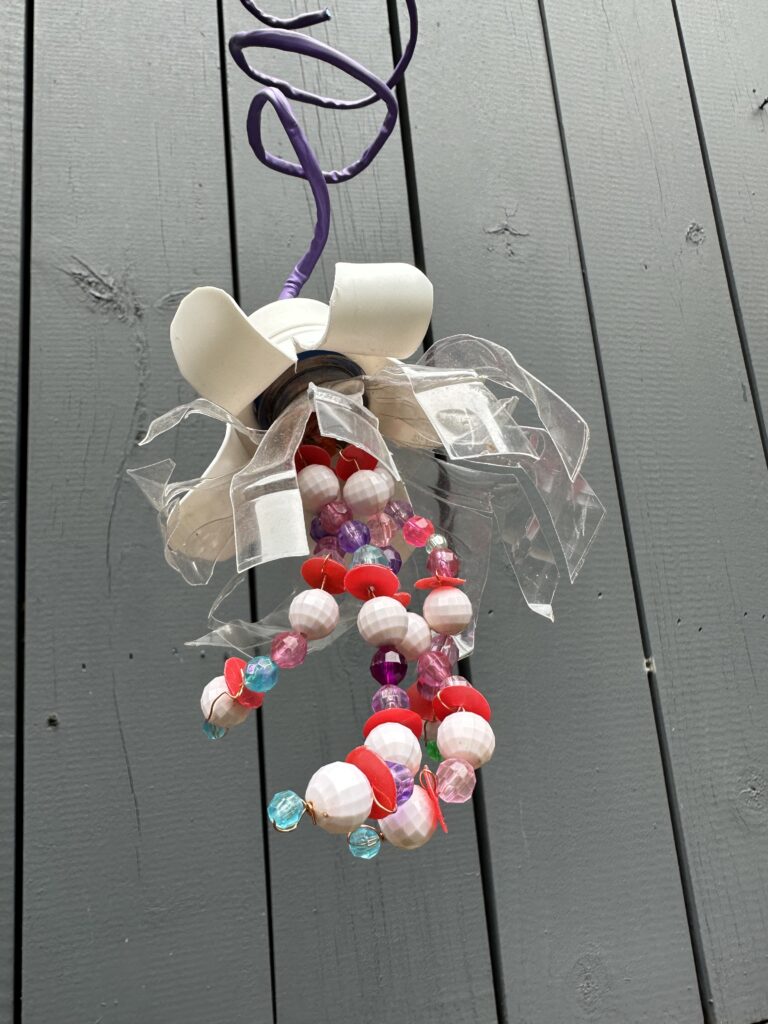
Image of a modern white pentamerous flower by Ann Morton of Street Gems made of a recycled light socket! Dr. Rebecca Klemm purchased the street gem at the museum store of the Phoenix Art Museum, Phoenix Arizona in 2023.
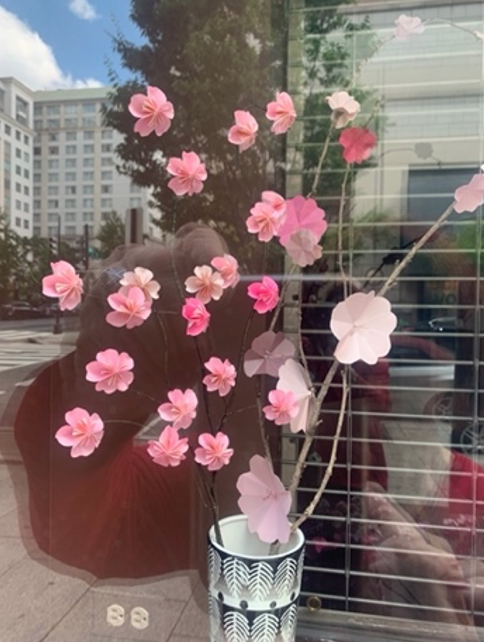
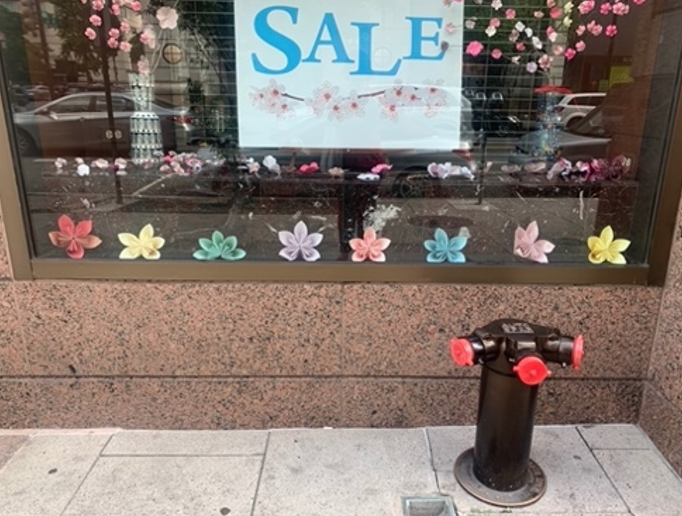
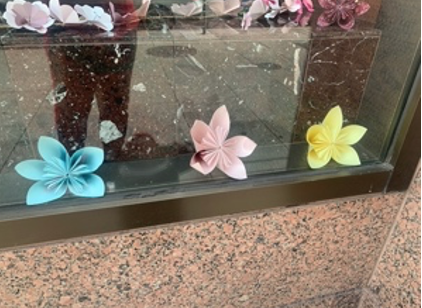
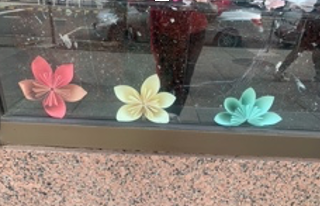
Paper-made pentamerous flowers. Pictures courtesy of Dr. Rebecca Klemm of a storefront in Washington, DC in 2023.
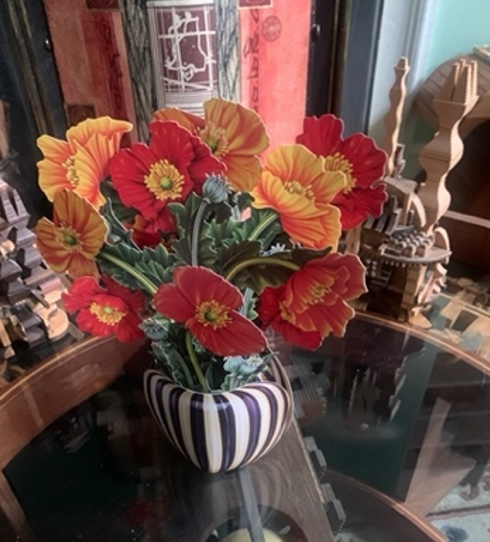
A pop-up hidden gem for your home. The image is of a gift that arrived flat but became 3D when popping up the vase. Image of the pop-up hidden gem in the home of Dr. Rebecca Klemm, August 2023.
Learning Guide

- What do you think the title has to do with the art?
- Why do you think Number Character 5 is speaking about Hidden Gems?
- Number Character 5 sees some pentamerous flowers in Hidden Gems. Can you find some? Show yourself and your friends and family.
- Why do you think Dr. Klemm included 5 red images with white numbers?
- From left to right, how do you think the shapes of the 2nd, 3rd and 5th red images with white numbers relate to plants in the art? Can you find the 2nd, 3rd and 5th images in the flowers or petals of Hidden Gems? (Hint: explore the purple Hellebore, small blue Brunerra and small green leaves included on the left side of the two-page spread.)
- Which of the red images with white numbers are pentamerous flowers?
- From left to right, which red image with white numbers is in the shape of a possible faceted gemstone? Which is a possible cabochon gemstone? (Hint: faceted are generally symmetric.) What is the geometric name of each of the two faceted and cabochon shapes?
- Using the images of faceted gemstones provided above, which cut type is the 1st (most left) hidden blue image?
- Using the images of faceted gemstones provided above, which cut type is the 4th from the left hidden blue image?
- From left to right, how do the 1st and 5th hidden blue images relate to each other?
- From left to right, how do the 2nd and 4th hidden blue images relate to each other? To the art?
- From left to right, how does the 3rd hidden blue image relate to the art? Is the image a pentamerous flower? Why?
- Do you see that the images (see above) in the shop window are pentamerous flowers? How would you make them of paper?
- Even if you cannot tell from the photo, Dr. Klemm assures you that the Street Gem is a pentamerous flower with 5 white petals cut from a light socket. How many cuts to the white plastic were required to make 5 petals?
- Which sapphire do you like best—the cabochon with the star or the brilliant cut? Why?
- Do you own any turquoise jewelry? What metal is turquoise jewelry often paired with?
- Looking at the images above, why do you think Tutankhamun’s mask and Dr. Klemm’s jewelry pair Lapis Lazuli with gold?
- Which metal, silver or gold, was most ancient jewelry made of? Why?
- Cleopatra used the dust of Lapis Lazuli for her eyeshadow- would you?
- What plants in your garden, the local park or neighborhood garden would you consider a hidden gem? What gems do you have in your personal life collection?
